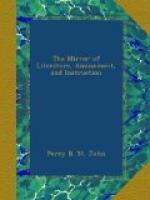From the Report of 1829, we also learn that the subscriptions were L3,439. the Dividends L3,798. and the Legacies L1,781. and the expenses of the year L9,731. including L709. for bedding, &c. for the new building.
The new building is from the designs of W. Wilkins, Esq. R.A. architect of the London University, &c. The Engraving represents the grand front which faces the Green Park, and consists of a centre and two wings, in all 200 feet in length. Part of the north wing, which we have referred to as facing Hyde Park, or stretching towards Knightsbridge, is also erected. The south wing is finished, and occupied by patients, as is also the south end of the east front. The theatre for lectures on surgery and medicine will accommodate 150 students. Immediately adjoining it is the museum of anatomical preparations. The entire edifice is faced with compost, coloured and checkered in imitation of stone. The hospital, when complete, will contain 29 wards, and 460 beds. The contracts for building the whole amount to about L41,000.
The grand front, seen from the Green Park, has a handsome appearance, and the architecture is simply elegant. Viewed in association with the costly arch entrance to the Gardens of Buckingham Palace, and the classic screen and gates to Hyde Park—the New Hospital gives rise to a grateful recollection of national benevolence as well as cultivation of fine art—of soothing life’s ills as well as embellishing its enjoyments—in short, of nurturing the first and best feelings of our nature as well as encouraging taste and talent. May England never halt in raising such monuments of her real greatness!
* * * * *
SUNSET THOUGHTS.
(For the Mirror.)
I’ve stood to gaze on the sunset
hill,
When the winds were hush’d and the
waves were still;
As the sun sank slowly down the west,
I thought of the good man dropping to
rest,
When his race is run—he yields
his breath,
And softly sinks in the slumber of death.
When I gazed on the gorgeous western sky,
I thought of those blissful bowers on
high,
Whose brightness—blessedness
serene,
Ear hath not heard—eye hath
not seen.
When I saw the golden glories die,
I thought on life’s uncertainty,
And as night came on in her ebon gloom,
Oh! I thought of the dark and the
dreamless tomb,
How soon man’s fairest prospects
flee,
The curtain drops—“And
where is he?”
Colbourne.
* * * * *
THE NOVELIST.
* * * * *
THE GOLDEN BODKIN.
An Illustration of Sayings and Doings.
(For the Mirror.)




